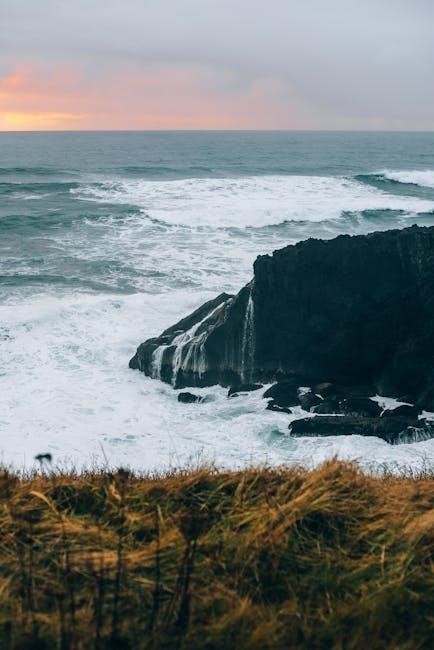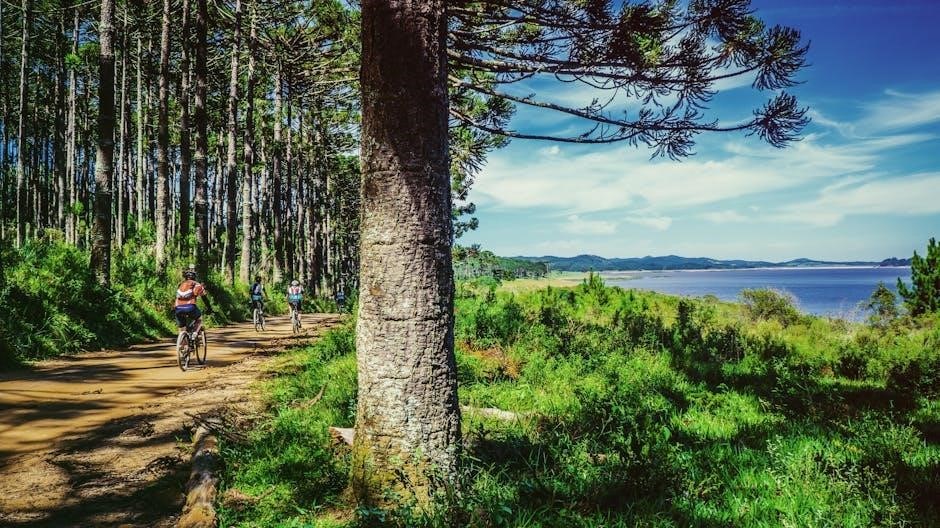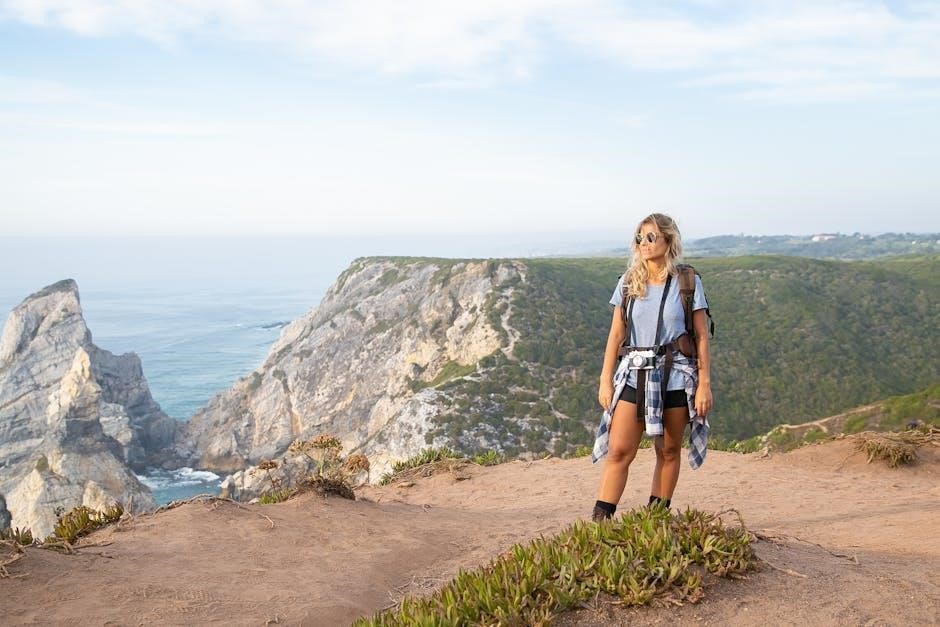The West Coast Trail Map PDF is an essential resource for hikers, offering detailed information about the 75 km trail on Vancouver Island. It highlights key points like trailheads, campsites, and landmarks, ensuring safe and informed navigation through the rugged terrain, old-growth forests, and coastal beaches.
Overview of the West Coast Trail
The West Coast Trail is a 75 km multi-day backpacking route located on Vancouver Island, British Columbia, Canada. Known for its rugged terrain, it spans from Pachena Bay to Gordon River, passing through ancient forests, sandy beaches, and rocky headlands. The trail features over 70 ladders, suspension bridges, and cable car crossings, making it a challenging yet rewarding adventure. Part of the Pacific Rim National Park Reserve, it offers stunning ocean views, abundant wildlife, and diverse ecosystems. Hikers need permits and should be prepared for unpredictable weather and physically demanding conditions. The trail map is crucial for navigation and planning.
Importance of a Trail Map for Hikers
A trail map is indispensable for navigating the West Coast Trail, ensuring hikers stay on course through its complex terrain. It provides detailed topography, marking campsites, water sources, and landmarks. With unpredictable weather and remote sections, the map helps locate emergency exits and nearest ranger stations. Digital versions offer GPS compatibility, enhancing accuracy, while paper maps serve as a reliable backup. Understanding the trail layout, elevation changes, and potential hazards is crucial for a safe and enjoyable experience. A map ensures hikers are prepared for every segment of their journey, fostering confidence and readiness for challenges ahead.

History and Significance of the West Coast Trail
The West Coast Trail originated as a lifeline for stranded mariners and was historically used by Indigenous Nations for trade and travel, embodying rich cultural and historical significance.
Indigenous Peoples and the Trail’s Origins
For centuries, the Huu-ay-aht, Ditidaht, and Pacheedaht First Nations inhabited Vancouver Island’s west coast, using trails and paddling routes for trade and travel long before European arrival. These Indigenous communities relied on the region’s abundant resources, establishing a deep connection with the land. The trail’s origins reflect their resilience and resourcefulness, as they navigated the rugged coastline and forests with skill. Their legacy continues to be honoured as an integral part of the West Coast Trail’s history and cultural identity.
Historical Use of the Trail for Trade and Travel
The West Coast Trail originated as a network of paths used by Indigenous Peoples for trade, ceremony, and survival. Early European settlers and traders later adopted these routes, navigating the rugged terrain to access remote coastal communities. The trail’s historical significance lies in its role as a lifeline, connecting villages and facilitating the exchange of goods. Its challenging landscape, marked by dense forests, swamps, and rivers, required ingenuity and perseverance. Over time, the trail evolved into a vital route for both Indigenous and European travelers, shaping the region’s cultural and economic history.
Quick Facts About the West Coast Trail
The West Coast Trail is a 75 km backpacking route on Vancouver Island, known for its rugged terrain, scenic beaches, and dense forests. It requires permits, is challenging, and features ladders, cable cars, and stunning coastal views.
Location and Length of the Trail
The West Coast Trail is situated on Vancouver Island, British Columbia, Canada, within the Pacific Rim National Park Reserve, a UNESCO World Heritage Site. Stretching approximately 75 kilometers, the trail runs from Bamfield in the north to Port Renfrew in the south. This iconic route winds through lush rainforests, crosses rugged coastlines, and offers stunning ocean vistas. Its diverse landscapes and challenging terrain make it a world-renowned hiking destination, attracting adventurers eager to explore one of Canada’s most pristine wilderness areas.
Difficulty Level and Required Experience
The West Coast Trail is considered a challenging multi-day hike, requiring a high level of physical fitness and outdoor experience. The trail features rugged terrain, including muddy sections, steep ladders, and uneven paths. Hikers must also navigate cable cars and rivers, adding to the adventure’s complexity. Due to its demanding nature, it is not suitable for beginners. A permit system ensures only prepared hikers attempt the trail, and prior backpacking experience is highly recommended. The terrain and unpredictable weather demand careful planning and sturdy gear to ensure a safe and enjoyable journey.
Unique Features of the Trail
The West Coast Trail boasts stunning natural beauty, with dramatic coastlines, ancient rainforests, and numerous water crossings via cable cars and ferries. Its remote location offers abundant wildlife, including bears, whales, and seals. Hikers encounter over 70 ladders and 130 bridges, adding to the trail’s adventurous appeal. The mix of beach walking, forest hiking, and rugged terrain makes each section unique. Historical remnants, such as old settlers’ trails and Indigenous pathways, enrich the experience, connecting hikers to the region’s rich cultural heritage. These features make the trail a standout destination for outdoor enthusiasts worldwide.
Planning and Preparing for the Hike
Planning and preparing for the West Coast Trail requires securing permits, choosing the right trailhead, and packing essential gear. Timing your hike with seasonal conditions is crucial for safety and success.
Permits and Reservations: What You Need to Know
Obtaining a permit is mandatory for hiking the West Coast Trail, as it helps manage the high volume of hikers. Permits can be secured through Parks Canada’s online reservation system. Demand is high, so reservations often sell out quickly. A non-refundable fee is required to book your spot, and there are limited spaces available. For the high season, a lottery system is in place to ensure fair access. If your plans change, cancellations must be made in advance to avoid penalties. Be prepared to show your permit upon entry to the trail.
Choosing the Right Trailhead
The West Coast Trail has two main trailheads: Pachena Bay in the north and Gordon River in the south. Both offer access to the 75 km route, but starting points vary in difficulty and logistics. Pachena Bay is often preferred for its easier initial terrain, while Gordon River challenges hikers with a river crossing. Ensure your transportation plan aligns with your chosen trailhead, as you’ll need a vehicle or shuttle at both ends; Reservations for trailheads are tied to permits, so plan carefully to avoid complications. Choosing the right start point sets the tone for your adventure.
Best Time to Hike the West Coast Trail
The optimal time to hike the West Coast Trail is during the dry season, typically from June to September, when weather conditions are more favorable. However, hikers should always check forecasts, as rain and fog can occur unexpectedly. The trail’s challenging terrain, including ladders, cable cars, and river crossings, demands preparedness. Plan your hike according to your experience level and physical condition, ensuring you’re ready for the rugged landscape. Early planning is crucial, as permits are required and sell out quickly. Be prepared for variable weather, even in the dry season, to ensure a safe and enjoyable journey.
Essential Gear and Supplies
For a successful hike on the West Coast Trail, packing the right gear is crucial. Hikers should bring sturdy hiking boots, waterproof jackets, and quick-drying clothing. A reliable backpack with rain cover, tent, and sleeping bag are must-haves. Navigation tools like a compass and the West Coast Trail Map PDF are vital for staying on track. Don’t forget a first-aid kit, headlamp, and water purification tablets. Food and snacks should be lightweight and high in energy. Sunscreen, insect repellent, and emergency shelter are also recommended. Always check the weather forecast and adjust your gear list accordingly to ensure safety and comfort throughout the journey.
The West Coast Trail Itself
The West Coast Trail spans 75 km on Vancouver Island, offering a challenging yet rewarding experience. It features rugged terrain, dense forests, and coastal views, with ladders and cable cars aiding navigation.
Overview of the Trail’s Landscape
The West Coast Trail traverses a diverse landscape, from dense temperate rainforests to rugged coastal beaches. Hikers encounter numerous ladders, suspension bridges, and cable cars, aiding passage over steep terrain and waterways. The trail also features scenic overlooks, hidden coves, and abundant wildlife, including bears and whales. Elevation changes are frequent, with the path winding through ancient forests and emerging onto vast, windswept shorelines. This dynamic terrain challenges hikers while offering breathtaking views, making the West Coast Trail a unique and unforgettable experience.
Notable Sections and Highlights
The West Coast Trail features several iconic sections that stand out for their beauty and challenge. The Grinder, a steep, ladder-heavy climb, is a memorable start for many hikers. The Ditidaht Region offers stunning coastal views, while the stretch near Chez Monique provides a welcome respite with its food and shelter. Michigan Creek is another highlight, known for its scenic beauty and wildlife spotting opportunities. These sections, along with the trail’s many cable car crossings and beachside camping spots, make the West Coast Trail a truly unforgettable hiking experience.
Challenges: Terrain, Obstacles, and Weather
The West Coast Trail presents numerous challenges, including rugged terrain with steep ladders, dense rainforests, and uneven ground. Hikers must navigate mud, roots, and rocks, while cable car crossings and fast-flowing rivers add complexity. Weather is unpredictable, with frequent rain and heavy fog reducing visibility. Wildlife encounters, such as bears, require caution. The trail’s remote nature means emergency rescues may involve boat evacuations. Proper preparation and physical conditioning are essential to tackle these obstacles safely and effectively, ensuring a successful and enjoyable hike along this iconic trail.
Day-by-Day Itinerary
The West Coast Trail is typically hiked over 5-7 days, divided into manageable sections. Each day offers unique highlights, such as beach camping, cable car crossings, and stunning viewpoints. Proper planning ensures a balanced pace, with stops at key locations like Tsusiat Falls and Chez Monique. Hikers must allocate time for challenging terrain, weather delays, and rest, making physical conditioning and preparation crucial for a successful journey.
Breaking Down the Trail into Manageable Sections
The West Coast Trail spans 75 km, typically completed in 5-7 days. Breaking it into daily sections helps manage the challenging terrain and varied landscapes. Day 1 often covers 12-15 km, easing hikers into the rhythm. Popular sections include the initial stretch from Pachena Bay to Michigan Creek, followed by the iconic Tsusiat Falls and Chez Monique. Each day balances hiking with rest, allowing time to explore tide pools, beaches, and forests. Proper planning ensures a steady pace, with built-in flexibility for weather delays or additional exploration of highlights like the Nitinat Narrows and Cape Beale.
Recommended Camping Spots
The West Coast Trail offers several designated campsites, each with unique features. Popular spots include Tsusiat Falls, known for its stunning waterfall, and Chez Monique, a historic site with basic amenities. Michigan Creek and Klanawa River are favored for their serene settings and access to freshwater. Additionally, Nitinat Narrows and Cape Beale provide breathtaking ocean views. These campsites are spaced to align with daily hiking goals, ensuring a balanced pace. Always check trail maps for exact locations and plan according to your itinerary. Reservations are required during peak season, and campsites fill up quickly.

Safety on the West Coast Trail
Hikers must stay alert for wildlife, steep drop-offs, and fast-changing weather. Carry a first aid kit and know emergency signaling techniques to ensure a safe journey.
General Safety Tips for Hikers
Preparedness is key to a safe hike on the West Coast Trail. Always carry a headlamp, map, and first aid kit. Be aware of changing weather conditions and potential hazards like steep drop-offs and fast-moving rivers. Stay visible by wearing bright clothing and avoid hiking alone. Keep emergency signaling devices accessible and know how to use them. Check trail conditions before starting and inform someone of your itinerary. Respect wildlife and maintain a safe distance. Ensure your phone is fully charged and consider carrying a portable charger. Familiarize yourself with the trail map to avoid getting lost. Stay alert and cautious, as the trail can be unpredictable.
Wildlife Encounters: What to Expect
The West Coast Trail is home to diverse wildlife, including bears, seals, and whales. Hikers may encounter black bears, so it’s crucial to store food and trash securely. Keep a safe distance if you spot wildlife and avoid sudden movements. Making noise while hiking can help prevent surprising animals; Be prepared for seal and whale sightings along the coastline. Never feed wildlife, as this can disrupt their natural behavior. Carry bear spray as a precaution and know how to use it. Respect wildlife habitats and follow park regulations to ensure a safe and enjoyable experience for both you and the animals.
Emergency Protocols and Rescue Information
Always carry a detailed map, GPS, and communication devices like a satellite phone or PLD, as cell service is limited. In emergencies, stay calm and visible. Use bright clothing, mirrors, or flares to signal for help. Parks Canada patrols the trail, but rescues can be delayed due to remote locations. Carry a first aid kit and know basic first aid. Whistles and emergency blankets are essential. Stay on marked trails to avoid disorientation. Inform someone of your itinerary and expected return time. Be prepared for unexpected weather changes and terrain challenges. Stay visible and signal rescuers clearly if needed.
Navigation Tools and Techniques
The West Coast Trail Map PDF, GPS devices, and the official West Coast Trail app are essential tools; Use them alongside physical maps for accurate route tracking and decision-making.
Using the West Coast Trail Map PDF
The West Coast Trail Map PDF is a vital navigation tool, providing detailed topography, trailheads, campsites, and landmarks. It helps hikers plan routes, identify safe crossings, and locate emergency exits. The map highlights essential points like ladders, cable cars, and river crossings, ensuring preparedness for challenging terrain. Hikers should use it alongside GPS devices and physical maps for cross-referencing. The PDF is downloadable from official sources, such as Parks Canada or trail associations, ensuring accuracy and reliability. Always carry a printed copy as a backup, especially in areas with limited GPS coverage. This resource is indispensable for a safe and enjoyable hike.
GPS Navigation and Digital Maps
GPS navigation is a crucial tool for hiking the West Coast Trail, offering precise location tracking and real-time updates. Apps like Gaia GPS and Maps.me allow users to download the trail map for offline use, ensuring navigation even without cell service. The West Coast Trail map PDF can be converted into GPS-compatible formats like .gpx, enabling hikers to mark waypoints for campsites, landmarks, and emergency exits. While GPS is highly reliable, it should always be used alongside a paper map, as devices can malfunction. Extra batteries and a backup power source are essential for extended hikes. Combining digital tools with traditional navigation enhances safety and ensures a smooth journey.
Signage and Markers Along the Trail
Signage and markers are strategically placed along the West Coast Trail to guide hikers and ensure safety. Directional signs at key junctions and metal markers on trees help navigate the 75 km route. These markers are especially important in dense forests and near coastal sections where visibility is limited. While the signage is reliable, hikers should remain vigilant, as some markers can be easy to miss. Additionally, informational signs provide insights into the trail’s history, wildlife, and ecosystems, enhancing the hiking experience. Always carry a map or GPS device as a backup to the trail’s signage system.
Environmental Considerations
Protecting the trail’s pristine ecosystem is crucial. Hikers must minimize their impact by following Leave No Trace principles, ensuring wildlife thrives and natural beauty is preserved for future generations.
Protecting the Trail’s Ecosystem
Preserving the West Coast Trail’s pristine environment is essential. Hikers must adhere to strict guidelines to minimize their ecological footprint. Parks Canada enforces regulations to protect the trail’s sensitive wildlife and vegetation. The permit system helps manage the number of hikers, reducing overcrowding and habitat disruption. Human impact, such as littering or damaging plants, can harm the fragile ecosystem. It is crucial for hikers to carry out all waste, avoid disturbing wildlife, and stay on designated paths. By respecting these rules, hikers help maintain the trail’s natural beauty for future generations to enjoy.
Leave No Trace Principles
The Leave No Trace principles are vital for preserving the West Coast Trail’s natural beauty. These guidelines emphasize minimizing environmental impact by carrying out all trash, staying on designated trails, and avoiding disturbance of wildlife or plants. Hikers should also keep campfires small and fully extinguish them before leaving. Additionally, respecting wildlife by maintaining a safe distance and not feeding animals is crucial. By following these principles, hikers help protect the trail’s delicate ecosystem and ensure its preservation for future adventurers. The official Leave No Trace organization provides detailed guidance for ethical outdoor practices.

West Coast Trail Map PDF: How to Download
Adhering to Leave No Trace principles is essential for preserving the West Coast Trail’s pristine environment. Hikers must minimize their impact by carrying out all trash, staying on designated paths, and avoiding disturbance of wildlife or vegetation. Campfires should be kept small and fully extinguished before leaving. Respecting wildlife by maintaining distance and not feeding animals is crucial. These practices ensure the trail remains untouched for future explorers. The official Leave No Trace guidelines provide detailed ethical outdoor practices for responsible hiking.
Official Sources for the PDF Map
The West Coast Trail Map PDF can be officially downloaded from Parks Canada’s website, specifically through the Pacific Rim National Park Reserve portal. This ensures an accurate and up-to-date map tailored for hikers. Additionally, third-party platforms like NWORTA provide downloadable versions, including Garmin and Google Earth formats. Always verify the source to avoid outdated or incomplete maps. The official Parks Canada website remains the most reliable option for a comprehensive and official trail map. Ensure to download the latest version before your hike for accurate navigation and planning.
Interactive and Digital Versions
Digital versions of the West Coast Trail map offer enhanced navigation and convenience. The West Coast Trail App provides an interactive map with real-time GPS tracking, allowing hikers to pinpoint their location. Digital maps are available on platforms like Garmin and Google Earth, offering detailed topography and waypoints. These versions are ideal for hikers preferring modern tools, ensuring accuracy and ease of use. They can be downloaded from official sources or third-party sites, providing a seamless experience for planning and navigating the trail. Digital maps are a valuable resource for both experienced and novice hikers.

Additional Resources for Hikers
Hikers can access detailed guidebooks, online forums, and mobile apps like the West Coast Trail App for real-time updates, trail guides, and community advice.
Guides, Apps, and Websites
Several resources are available to assist hikers. The West Coast Trail App provides an interactive map, trail details, and real-time updates. Official Parks Canada websites offer permits and trail updates. Guidebooks like The West Coast Trail: A Hiker’s Guide detail routes and history. Online forums and communities share hiker experiences and tips. Websites like westcoasttrail.com offer comprehensive planning tools and gear lists, ensuring hikers are well-prepared for their journey.
Community Forums and Hiker Testimonials
Online forums and hiker testimonials provide invaluable insights for planning a West Coast Trail adventure. Many hikers share their experiences, tips, and challenges, offering firsthand accounts of the trail’s difficulty and beauty. Wildlife encounters, such as bear and whale sightings, are frequently highlighted. Forum discussions also cover practical advice on gear, camping spots, and navigating challenging sections like ladders and cable cars. These platforms foster a sense of community, allowing hikers to connect, ask questions, and learn from others who have completed the trail. Testimonials often emphasize the trail’s transformative experience and the importance of preparation.
The West Coast Trail offers an unforgettable adventure, blending stunning landscapes with challenging terrain. Proper preparation and the West Coast Trail Map PDF are key to a successful journey, ensuring hikers can navigate safely and fully immerse themselves in this iconic experience.
Final Tips for a Successful Hike
To ensure a successful hike on the West Coast Trail, thoroughly study the map PDF and plan your itinerary. Check weather forecasts and tide times, as coastal sections may be impassable at high tide. Pack essential gear, including a first aid kit, headlamp, and water purification tablets. Respect wildlife and follow Leave No Trace principles to preserve the trail’s ecosystem. Stay hydrated, carry a backup power source for GPS devices, and inform someone of your route. Assess your physical fitness and consider starting with shorter sections if new to long-distance hiking. Enjoy the breathtaking scenery and challenging terrain responsibly.
Why the West Coast Trail is a Must-Hike Destination
The West Coast Trail is a must-hike destination for its iconic landscapes and unforgettable challenges. Stretching 75 km along Vancouver Island, it offers stunning coastal beaches, temperate rainforests, and rugged terrain. Hikers encounter historic ladders, cable cars, and diverse wildlife, making it a true adventure. The trail’s rich history, tied to Indigenous communities and early traders, adds depth to the journey. Its reputation as a challenging yet rewarding hike attracts outdoor enthusiasts worldwide. Completing the trail fosters a sense of accomplishment and connection to nature, making it a transformative experience for any hiker.